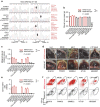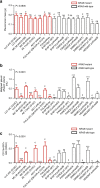Mutant KRAS promotes malignant pleural effusion formation
- PMID: 28508873
- PMCID: PMC5440809
- DOI: 10.1038/ncomms15205
Mutant KRAS promotes malignant pleural effusion formation
Abstract
Malignant pleural effusion (MPE) is the lethal consequence of various human cancers metastatic to the pleural cavity. However, the mechanisms responsible for the development of MPE are still obscure. Here we show that mutant KRAS is important for MPE induction in mice. Pleural disseminated, mutant KRAS bearing tumour cells upregulate and systemically release chemokine ligand 2 (CCL2) into the bloodstream to mobilize myeloid cells from the host bone marrow to the pleural space via the spleen. These cells promote MPE formation, as indicated by splenectomy and splenocyte restoration experiments. In addition, KRAS mutations are frequently detected in human MPE and cell lines isolated thereof, but are often lost during automated analyses, as indicated by manual versus automated examination of Sanger sequencing traces. Finally, the novel KRAS inhibitor deltarasin and a monoclonal antibody directed against CCL2 are equally effective against an experimental mouse model of MPE, a result that holds promise for future efficient therapies against the human condition.
Conflict of interest statement
L.A.S. is an employee of the company that produces the anti-CCL2 antibodies. The remaining authors declare no competing financial interests.
Figures





References
-
- Davies H. E. et al.. Effect of an indwelling pleural catheter versus chest tube and talc pleurodesis for relieving dyspnea in patients with malignant pleural effusion: the TIME2 randomized controlled trial. JAMA 307, 2383–2389 (2012). - PubMed
-
- Ryu J. S. et al.. Prognostic impact of minimal pleural effusion in non-small-cell lung cancer. J. Clin. Oncol. 32, 960–967 (2014). - PubMed
-
- Wu S. G. et al.. Survival of lung adenocarcinoma patients with malignant pleural effusion. Eur. Respir. J. 41, 1409–1418 (2013). - PubMed
-
- Stathopoulos G. T. et al.. A central role for tumor-derived monocyte chemoattractant protein-1 in malignant pleural effusion. J. Natl. Cancer Inst. 100, 1464–1476 (2008). - PubMed
Publication types
MeSH terms
Substances
LinkOut - more resources
Full Text Sources
Other Literature Sources
Medical
Molecular Biology Databases
Research Materials
Miscellaneous

